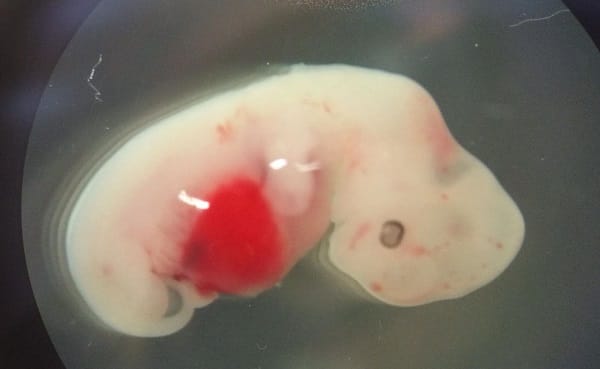The creation of an interspecies embryo in the lab sends tremors through the scientific world and beyond. This pig embryo containing human cells presents many exciting possibilities, such as creating human organs in pigs to end the overwhelming shortage of organs for transplant. But interspecies chimeras and their applications also pose important ethical questions.
The world of stem cells is a magnificent one. The potential to generate any given tissue or even entire organs has inspired many scientists to perform research on these flexible cells, which has already led to new treatments for various diseases and insights into the development of embryos, tissues, and organs.
Now, a great leap has been made in the stem cell field: scientists have been able to generate single embryos with stem cells from two different species. While the first rat−mouse hybrids, or chimeras, didn’t cause that much of a stir, the second type of chimera surely did. The creation of a human−pig embryo is a groundbreaking scientific feat, but sensational newspapers and clickbait articles stretch the truth of what’s happening too far for us to stand by, so we decided to break it down for you.
What did they do?
In a first attempt to determine whether interspecies chimeras were even possible, scientists at the Salk Institute in La Jolla, California, chose to inject mouse zygotes (fertilized eggs) with rat stem cells, as the two rodent species are very similar. The experiment was a success: the first mouse−rat chimera was born, developed, and aged normally. The researchers also investigated whether injected stem cells would complement a deficient embryo. A mouse zygote deficient in the gene to develop a pancreas was injected with rat stem cells and, lo and behold, formed a fully functioning pancreas, effectively creating a mouse with a rat pancreas.
Next, the researchers decided to up the ante. What would happen with cells from more distantly related species? Rat stem cells were shown to not blend well with pig embryos, but this was not the case for stem cells of human origin. Human stem cells in the right stage of maturation can combine with pig zygotes, which then progress normally to embryo formation. But don’t go all “Pig-men are here” now! The porcine embryo consisted of only 0.001% human cells, showing that we’re far from an equal blend of cells from distantly related species.

So where can we see the pigs with human cells, you ask? Actually, we can’t. The hybrid embryos developed normally for the first four weeks, after which they were destroyed. Compliance with ethical guidelines is of the utmost importance when conducting this kind of revolutionary research!
Why is this important?
So why try this Frankenstein-like stuff in the first place? Well, chimeras with human cells can teach us a lot about early development, of both entire embryos and single cells during differentiation and the formation of organs. Chimeras might also provide a platform to explore new disease models or test innovative medicines intended for human use.
The most important reason for continuing chimera research, however, is that it may help scientists learn to grow human organs in other species. The experiment that successfully grew a rat pancreas within a mouse is an encouraging first step toward developing this technique and hints at the possibility of growing human organs in other species. As pigs resemble humans in many physiological and anatomical aspects, they are the obvious candidates. Demand for organs is currently four times the supply, so there is an urgent need for a solution. Animal-grown organs might provide the answer in the future, but we’re still far from that goal.


